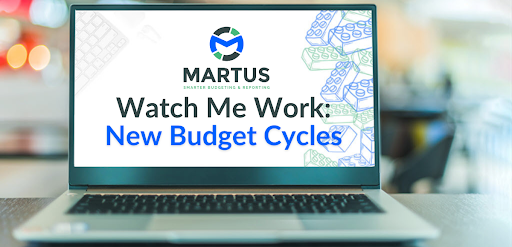Drowning in Spreadsheets? How This Little API Brings Your Financial Data to Life
Nonprofit finance teams are no strangers to the frustration of staring at overwhelming spreadsheets, struggling to translate rows of numbers into...
3 min read
Martus Solutions : July 23, 2024

Embarking on a new budgeting cycle might seem daunting, but with the right tools and guidance, it can be a smooth and efficient journey. In our recent Watch Me Work webinar, we demonstrate how you can use Martus Solutions for reporting, forecasting, and budgeting. This post highlights the key points discussed in the webinar, providing you with a comprehensive guide to starting your new budgeting cycle with confidence.
Whether you're creating a new budget from scratch or updating an existing one, Martus Solutions provides the flexibility and functionality needed to meet your organization’s unique budgeting requirements.

The first step in setting up a new budget cycle is configuring the budget year on the planner setup page. Martus Solutions offers several budget creation options to suit different needs:
Once the budget is created, it is crucial to set it as the planner default. This ensures that the budget will be the primary one used for planning purposes. It is important to understand the difference between the planner default and dashboard default budgets. The planner default budget is used for planning and updating, while the dashboard default budget is used for reporting.

To allow non-admin users to view certain budgets, use the "Set Viewable" option. This provides specific permissions to users who need access to the budget without granting them full administrative rights.
Unlocking worksheets is a necessary step for budget owners to make any changes. Setting or updating gain/loss targets can be done either by percentage or manually, depending on the organization’s preferences.

Special Purpose Worksheets (SPWs) play a vital role in detailed budgeting. They allow for breaking down specific budget lines, such as consulting fees or utilities, into more manageable parts. This detailed approach helps maintain a clear and organized budget. The aqua icon for these is demonstrated below.

SPWs are incredibly helpful in managing detailed budget lines. They are used for specific areas like travel, events, and utilities, ensuring that each aspect of the budget is meticulously planned and organized. By using SPWs, organizations can track and manage expenses more effectively, making the budgeting process more transparent and accurate.
Understanding the "Frozen" and "Locked" statuses is crucial for maintaining budget integrity:
Before making significant changes, it is essential to archive the current budget. Archiving creates a secure backup, preserving the budget’s current state. This practice helps maintain an organized budgeting process and provides a safety net if any issues arise during updates.
To ensure that the budget data is reflected accurately in your accounting software, follow these steps to push the budget from Martus Solutions to systems like Intacct or QuickBooks:
For any specific guidance or training sessions, utilize Martus Solutions’ customer support.
Martus Solutions offers a series of upcoming webinars to further enhance your budgeting skills. These sessions provide additional training and refreshers on budgeting and reporting, helping you stay up-to-date with the latest features and best practices. Don’t miss the opportunity to learn more and improve your budgeting process. Check out our resource library and take the next step towards financial excellence.

Nonprofit finance teams are no strangers to the frustration of staring at overwhelming spreadsheets, struggling to translate rows of numbers into...

Nonprofit budgeting is more than a financial process—it’s a mission strategy. And yet, for many organizations, budgeting still feels like an...
![[New Guide] How to Make Nonprofit Reporting Clear, Useful, and Actionable](https://www.martussolutions.com/hubfs/Martus%20Customer%20Success.png)
You’ve seen the looks. The glazed-over eyes. The polite nods. The “Can we circle back to that?” deflection when you present the financial report at a...